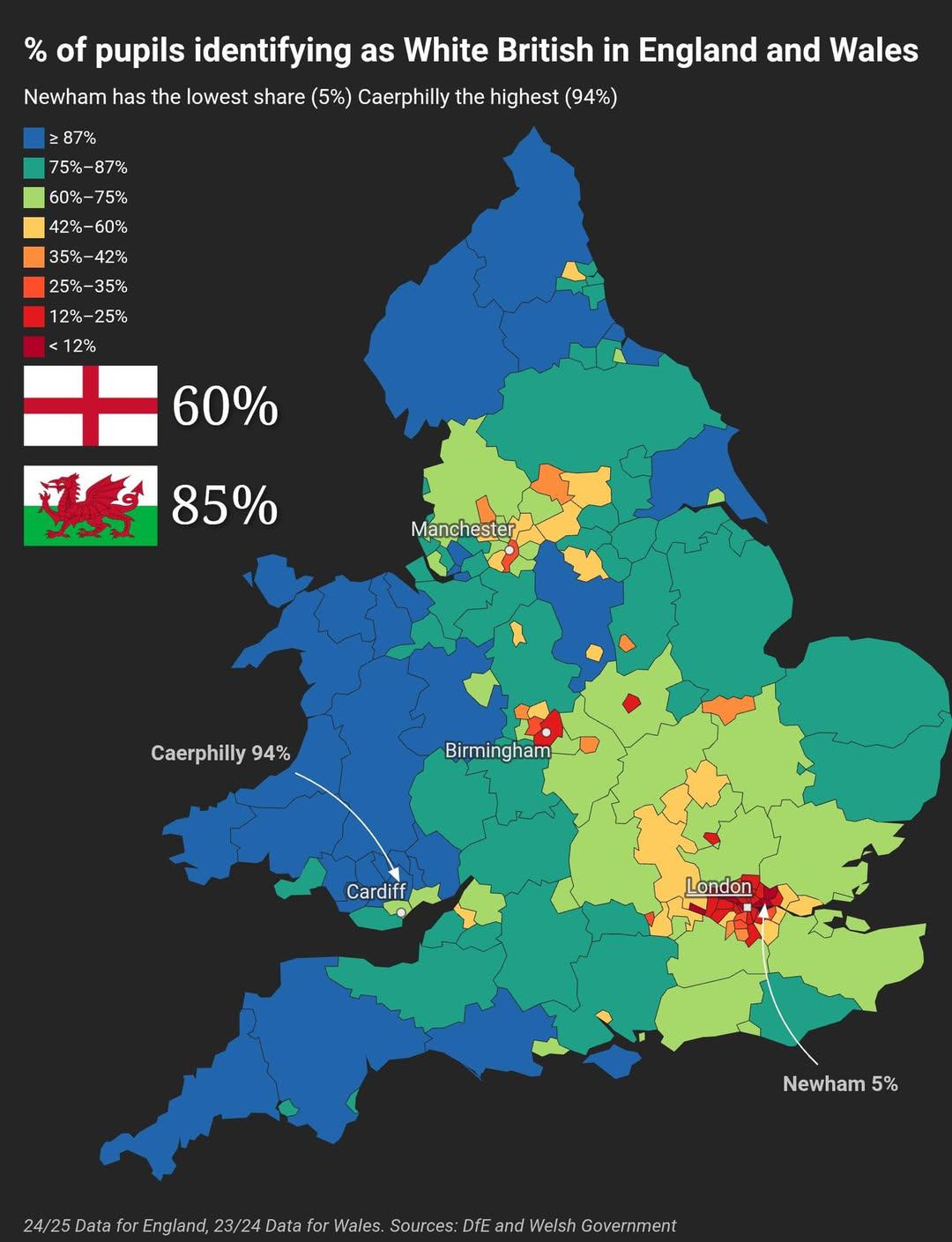% of Pupils Identifying as White British in England and Wales Map


Alex Cartwright
Senior Cartographer & GIS Specialist
Alex Cartwright is a renowned cartographer and geographic information systems specialist with over 15 years of experience in spatial analysis and data...
Geographic Analysis
What This Map Shows
This map illustrates the percentage of pupils identifying as White British in England and Wales, providing a visual representation of demographic trends across various regions. The data is drawn from recent educational statistics, capturing the diversity of student populations in schools. The visualization serves as a crucial tool for understanding not just the ethnic composition of students, but also the broader implications for society, education policy, and community dynamics.
Deep Dive into Ethnic Demographics in Education
Ethnic demographics in education play a pivotal role in shaping the experiences and outcomes of students. The category of 'White British' represents a significant segment of the population, and understanding its distribution can reveal much about social integration, resource allocation, and cultural representation in schools. Interestingly, the term 'White British' encompasses individuals whose roots lie in the UK, including those from England, Wales, Scotland, and Northern Ireland. However, the dynamics of this group can vary widely from one area to another.
In recent years, the landscape of school demographics has shifted due to various factors, including immigration, urbanization, and changing birth rates. According to the latest statistics, the percentage of pupils identifying as White British has been declining gradually, particularly in urban areas where multiculturalism is more pronounced. In London, for example, the percentage of pupils identifying as White British has dipped below 30%, showcasing a significant shift in the ethnic makeup of the student body. Conversely, rural areas and smaller towns may still exhibit higher percentages of White British pupils, reflecting a more homogeneous demographic.
The reasons behind these shifts are multifaceted. For one, the influx of families from diverse ethnic backgrounds seeking better economic opportunities has transformed local demographics. Schools in areas with high immigrant populations often reflect this diversity, with a rich tapestry of cultures enriching the educational experience. However, this can also present challenges, such as the need for tailored educational resources that cater to multilingual students and varying cultural backgrounds.
What's fascinating is how these demographic changes can impact educational outcomes. Research indicates that diverse classrooms can enhance social cohesion and foster an inclusive environment, yet they also necessitate effective teaching strategies to address different learning needs. This makes it essential for educators and policymakers to pay close attention to the ethnic composition of their student populations, ensuring that all pupils receive equal opportunities to thrive.
Regional Analysis
Examining the map, it becomes clear that regions vary significantly in their proportions of pupils identifying as White British. For instance, in the North East of England, many areas still report over 90% of pupils identifying as White British, indicating a relatively homogeneous population. This is a stark contrast to metropolitan areas such as Birmingham and Manchester, which showcase a much more diverse student body, with White British pupils often making up less than half of the total.
For example, Birmingham, with its rich multicultural heritage, has schools where the White British population is around 30%. This diversity is reflected in school celebrations, language offerings, and community engagement initiatives. On the other hand, in counties like Northumberland, the predominantly White British demographic can lead to different educational challenges, such as a lack of multicultural awareness and engagement with wider societal issues.
Similarly, in Wales, the map reveals a complex picture. While urban areas like Cardiff showcase increasing diversity, rural regions tend to have a higher percentage of White British pupils. This duality highlights the need for targeted educational policies that address the unique challenges and opportunities in each region.
Significance and Impact
Understanding the percentage of pupils identifying as White British in England and Wales is crucial for various reasons. Firstly, it helps educators and policymakers identify trends that could affect resource allocation, curriculum development, and community involvement. As the demographic landscape continues to evolve, it becomes imperative for schools to implement inclusive practices that reflect the diverse society in which they operate.
Moreover, this topic resonates beyond the classroom. It connects to broader discussions about national identity, social cohesion, and the importance of embracing multiculturalism. As communities become increasingly diverse, fostering an environment of understanding and respect becomes paramount. The future implications of these demographic trends are profound, as they can influence social policies, community relations, and even economic opportunities in the years to come.
In conclusion, the percentage of pupils identifying as White British is more than just a statistic; it’s a window into the shifting cultural landscape of England and Wales. As educators and communities navigate these changes, the focus must remain on fostering an inclusive environment that celebrates diversity while ensuring that every pupil has the opportunity to succeed. With ongoing demographic changes, the educational landscape will continue to evolve, making it essential to stay informed and proactive in addressing these challenges.
Visualization Details
- Published
- October 15, 2025
- Views
- 68
Comments
Loading comments...